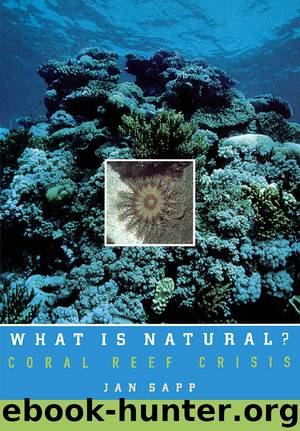What Is Natural? by Jan Sapp

Author:Jan Sapp
Language: eng
Format: epub
ISBN: 9780195123647
Publisher: Oxford University Press
Published: 2015-03-13T10:11:03+00:00
THE GBRMPA
Kenchington thought it unlikely that the occurrence of such a phenomenon affecting the Great Barrier Reef would ever again develop into so complex a controversy. In the first place, the crown-of-thorns controversy had led to a greater general understanding of reef processes. However, there was another major consequence. New policy decisions and investments had established a body responsible for reef conservation—the Great Barrier Reef Marine Park Authority (GBRMPA, pronounced “gebrumpa”), which possessed well-equipped and well-staffed laboratories as well as research vessels for reef research.55 In 1978, Kenchington was appointed its Director of Research and Planning.
Legislation passed in 1975 made the Great Barrier Reef a marine park. That legislation was considered a great triumph for Australian environmentalists who had sketched a dramatic scenario of narrow interests of big business irrevocably destroying the great ecosystem. Oil drilling, mining, and other ecologically harmful activities were banned in perpetuity.56 It is the largest marine park in the world; larger than Great Britain: 2000 km long, covering an area of 348,700 km2 and comprising 2900 individual reefs, 300 reef islands or cays, 600 high is-lands, home to 1500 species of fish, over 4000 species of mollusks, and 450 species of corals. The unique environment of the Great Barrier Reef led to its inscription in October 1981 on the UNESCO World Heritage List.57
The GBRMPA regulated all recreational, business, construction, and research activities of the entire territory of the Great Barrier Reef.58 Its management plan provided a model for juggling exploitation and protection of reefs in many countries. Over the next decade, tourism to the Great Barrier Reef attracted some 800,000 visitors annually. Many traveled to major new resort complexes. The most luxurious had an indoor ice-skating rink; the largest accommodated 11,000 guests. In the late 1980s, the area also featured the world’s first offshore hotel—a seven-story structure built on a massive pontoon. The enormous increase in the human population along with the demands of shell collectors, divers, and commercial fishermen were regulated by a pioneering zoning system.59
Two “general-use zones” covered 97% of the park. The larger of these zones permitted commercial trawling and shipping; the other banned both and required permits for such activities as shell collecting and low-level aviation. Another 2% of the park was divided into three other zones that spelled out in detail what users, especially fishers, can or cannot do. One was a “look, but don’t catch” area, another allowed only trolling for pelagic species, a third confined line fishermen to one handheld rod with a single hook or lure. The park’s remaining 1% was cordoned off for scientific research, replenishment of marine life, and the preservation of areas in a state undisturbed by humans.60
In the 1980s, coral-reef communities around the world were estimated to cover about one million square kilometers (600,000 square miles). Most exist in poor countries where silt from erosion on logged-over watersheds often suffocated the coral. In other areas, sewage disposal, pollution, oil drilling, overfishing, dynamiting and other activities of ever-increasing human populations exacted high tolls. The
Download
This site does not store any files on its server. We only index and link to content provided by other sites. Please contact the content providers to delete copyright contents if any and email us, we'll remove relevant links or contents immediately.
The Lonely City by Olivia Laing(4772)
Animal Frequency by Melissa Alvarez(4430)
All Creatures Great and Small by James Herriot(4272)
Walking by Henry David Thoreau(3925)
Exit West by Mohsin Hamid(3796)
Origin Story: A Big History of Everything by David Christian(3666)
COSMOS by Carl Sagan(3590)
How to Read Water: Clues and Patterns from Puddles to the Sea (Natural Navigation) by Tristan Gooley(3434)
Hedgerow by John Wright(3319)
How to Read Nature by Tristan Gooley(3294)
The Inner Life of Animals by Peter Wohlleben(3285)
How to Do Nothing by Jenny Odell(3264)
Project Animal Farm: An Accidental Journey into the Secret World of Farming and the Truth About Our Food by Sonia Faruqi(3191)
Origin Story by David Christian(3170)
Water by Ian Miller(3157)
A Forest Journey by John Perlin(3044)
The Plant Messiah by Carlos Magdalena(2900)
A Wilder Time by William E. Glassley(2837)
Forests: A Very Short Introduction by Jaboury Ghazoul(2815)
